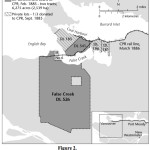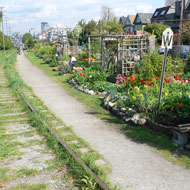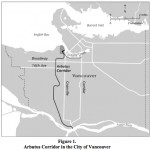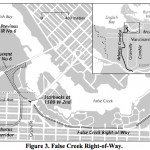For the next League gathering, we will attempt different ways of pacing out, taking in, and exploring a unique urban space — the 11-km-long Arbutus rail corridor. The League challenge is to read a bit about the history below (or much more here), choose your tools, and find your own way to walk the line, with or without others in the group. How will you connect to the space? Will your expedition focus on length or duration, on the bodies of water that anchor the corridor, on the social histories the space embodies, on the things that might grow along the strip, on actions you could enact, or the objects you might find or bring?
When: Sunday 28 July 2013
Where: Meet at the 1st and Fir Railway Garden at noon
Duration: as long as it takes
Bring: any tools you might need
The Arbutus rail corridor
Once upon a time a city gave itself away in order that a great railway might be induced to establish its terminus there.1
The Arbutus Corridor in Vancouver is an intact 11 km rail line running north-south between False Creek and the Fraser River. This 50-to-65-foot-wide strip of land condenses many of the histories and issues of land use in the city.
Part of the large parcel of provincial land granted in 1886 to the Canadian Pacific Railroad to induce the company to move its western terminus to Vancouver, it was used for freight and passenger service from 1902 to 1954, then freight only until 2001, when it was abandoned.2
As the CPR prepared to cease operations on the line, the City of Vancouver in 2000 developed an Official Development Plan for the land, protecting it from development and designating it as a multi-use transportation/greenway corridor. The validity of that plan was unsuccessfully challenged by CPR in the BC Court of Appeals.
 The corridor passes through traditional First Nations territories: the Musqueam in the southern Fraser River portion, and the Squamish in the northern False Creek area. The northern end of the Arbutus Corridor was extended in 1886 as the CPR expropriated part of the Squamish Indian Reserve No. 6 (False Creek) in order to extend the rail line to English Bay. As directed by the courts in 2002, that portion has been returned to the reserve as it was no longer used for railway purposes. The False Creek Right-of-Way branching from the Arbutus Corridor was acquired by the city in 1996 after a small portion — where Starbucks now stands on 2nd Avenue under the Granville Bridge — was sold to a developer.
The corridor passes through traditional First Nations territories: the Musqueam in the southern Fraser River portion, and the Squamish in the northern False Creek area. The northern end of the Arbutus Corridor was extended in 1886 as the CPR expropriated part of the Squamish Indian Reserve No. 6 (False Creek) in order to extend the rail line to English Bay. As directed by the courts in 2002, that portion has been returned to the reserve as it was no longer used for railway purposes. The False Creek Right-of-Way branching from the Arbutus Corridor was acquired by the city in 1996 after a small portion — where Starbucks now stands on 2nd Avenue under the Granville Bridge — was sold to a developer.
The corridor is now marked by growth of all kinds, ranging from several community gardens to overgrown brambles, while varying opinions and proposals about the fate of the strip continue to exist.
Notes
1. W. Playfair, “Vancouver and the Railways,” (June 1911) British Columbia Magazine at 498, cited in Douglas C. Harris, “A Railway, a City, and the Public Regulation of Private Property: CPR v City of Vancouver,” 31 March 2011.
2. Historical details rely on Douglas C. Harris, “A Railway, a City, and the Public Regulation of Private Property: CPR v City of Vancouver,” 31 March 2011. Link at http://www.law.ualberta.ca/plpr/2011/Harris_Constructive_Taking_2011.pdf.




